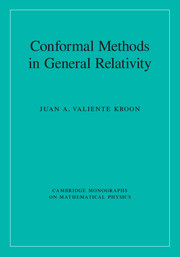Book contents
- Frontmatter
- Dedication
- Contents
- Preface
- Acknowledgements
- List of Symbols
- 1 Introduction
- Part I Geometric tools
- 2 Differential geometry
- 3 Spacetime spinors
- 4 Space spinors
- 5 Conformal geometry
- Part II General relativity and conformal geometry
- Part III Methods of the theory of partial differential equations
- Part IV Applications
- References
- Index
3 - Spacetime spinors
from Part I - Geometric tools
- Frontmatter
- Dedication
- Contents
- Preface
- Acknowledgements
- List of Symbols
- 1 Introduction
- Part I Geometric tools
- 2 Differential geometry
- 3 Spacetime spinors
- 4 Space spinors
- 5 Conformal geometry
- Part II General relativity and conformal geometry
- Part III Methods of the theory of partial differential equations
- Part IV Applications
- References
- Index
Summary
The notion of spinors arises naturally in the construction of a relativistic firstorder equation for a quantum wave function – the so-called Dirac equation. Spinors are the most basic objects to which one can apply a Lorentz transformation. The seminal work in Penrose (1960) has shown that spinors constitute a powerful tool to analyse the structure of the Einstein field equations and their solutions. Most applications of spinors in general relativity make use not of the Dirac spinors but of the so-called 2-spinors. The latter are more elementary objects, and indeed, the whole theory of the Dirac equation can be reformulated in terms of 2-spinors. In the sequel, 2-spinors will be very often simply called spinors.
The purpose of this chapter is to develop the basic formalism of spinors in a spacetime. Accordingly, one speaks of spacetime spinors, sometimes also called SL (2, C) spinors; see, for example, Ashtekar (1991). A discussion of spinors in the presence of a singled-out timelike direction, the so-called space spinor formalism, is given in Chapter 4. One of the motivations for the use of spinors in general relativity is that they provide a simple representation of null vectors and of several tensorial operations. Although spinors will be used systematically in this book, they are not essential for the analysis. All the key arguments could be carried out in a tensorial way at the expense of lengthier and less transparent computations.
The presentation in this chapter differs sligthly in focus and content from that given in other texts; see, for example, Penrose and Rindler (1984); Stewart (1991); O'Donnell (2003). For reasons to be discussed in the main text, a systematic use of the so-called Newman-Penrose formalism will be avoided – although the basic notational conventions of Penrose and Rindler (1984), the authoritative work on the subject, are retained.
Algebra of 2-spinors
In what follows let (M, g) be a spacetime. The present discussion begins by analysing spinorial structures at a given point p of the spacetime manifold M. The concept of a spinor is closely related to the representation theory of the group SL (2,C). This group has two inequivalent representations in terms of two-dimensional complex vector spaces which are complex conjugates of each other; for a discussion of this aspect of the theory, see, for example, Carmeli (1977); Sexl and Urbantke (2000).
- Type
- Chapter
- Information
- Conformal Methods in General Relativity , pp. 64 - 93Publisher: Cambridge University PressPrint publication year: 2016



